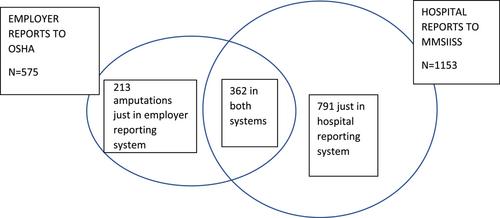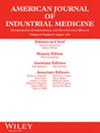Evaluation of the characteristics of injured workers and employer compliance with OSHA's reporting requirement for work-related amputations
Abstract
Introduction
In 2014, the Federal Occupational Safety and Health Administration (OSHA) enacted a standard requiring employers to report work-related amputations to OSHA within 24 hours. We studied the characteristics of the injured workers and employer compliance with the regulation in Michigan.
Methods
Two independent data sets were used to compare work-related amputations from 2016 to 2018: employer reports to OSHA and the Michigan Multi-Source Injury and Illness Surveillance System (MMSIISS). We deterministically linked employer reports to OSHA with the MMSIISS by employee name, employer name, date, and type of amputation.
Results
We identified 1366 work-related amputations from 2016 to 2018; 575 were reported by employers to OSHA and 1153 were reported by hospitals to the MMSIISS. An overlap of 362 workers were reported in both systems, while 213 workers were only reported by employers to OSHA and 791 workers were only reported by hospitals. Employer compliance with the regulation was 42.1%. Employer compliance with reporting was significantly less in: agriculture, forestry, fishing, and hunting (14.6%); construction (27.4%); retail trade (20.7%); arts, entertainment, and recreation (7.7%); accommodation and food services (13.0%); and other services (27.0%). Large employers and unionized employers were significantly more likely (67.9% and 92.7%, respectively) and small employers were significantly less likely (18.2%) to comply with the reporting rule. Enforcement inspections at 327 workplaces resulted in 403 violations; of those, 179 (54.7%) employers had not corrected the amputation hazard before the time of inspection.
Discussion
Michigan employers reported less than half of the work-related amputations required by OSHA's reporting regulation. Noncompliance was greatest in small employers, and agriculture, forestry, fishing, and hunting; construction; arts, entertainment, and recreation; accommodation and food services; and retail and other service industries. Inspections found that over half of the employers had not corrected the hazard that caused the amputation at the time of the inspection's initial opening date; in these cases, abatement of any hazards identified would have occurred after the inspection. Improved compliance in employer reporting of work-related amputations will identify hazards posing a high risk of recurrence of injury to other workers from the same injury source. Greater compliance can also help target safety-related preventive and intervention efforts in industries that might otherwise be overlooked.


 求助内容:
求助内容: 应助结果提醒方式:
应助结果提醒方式:


